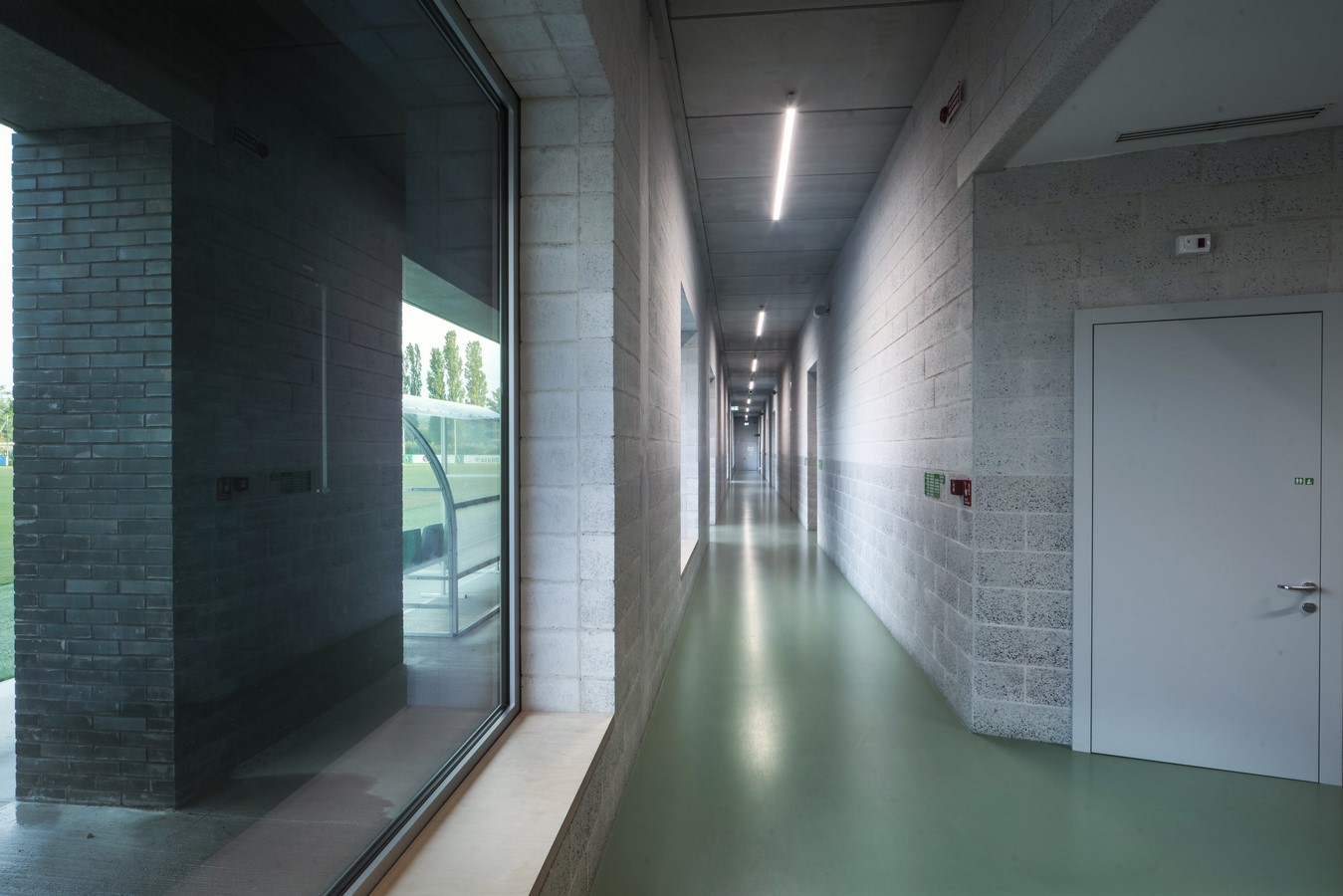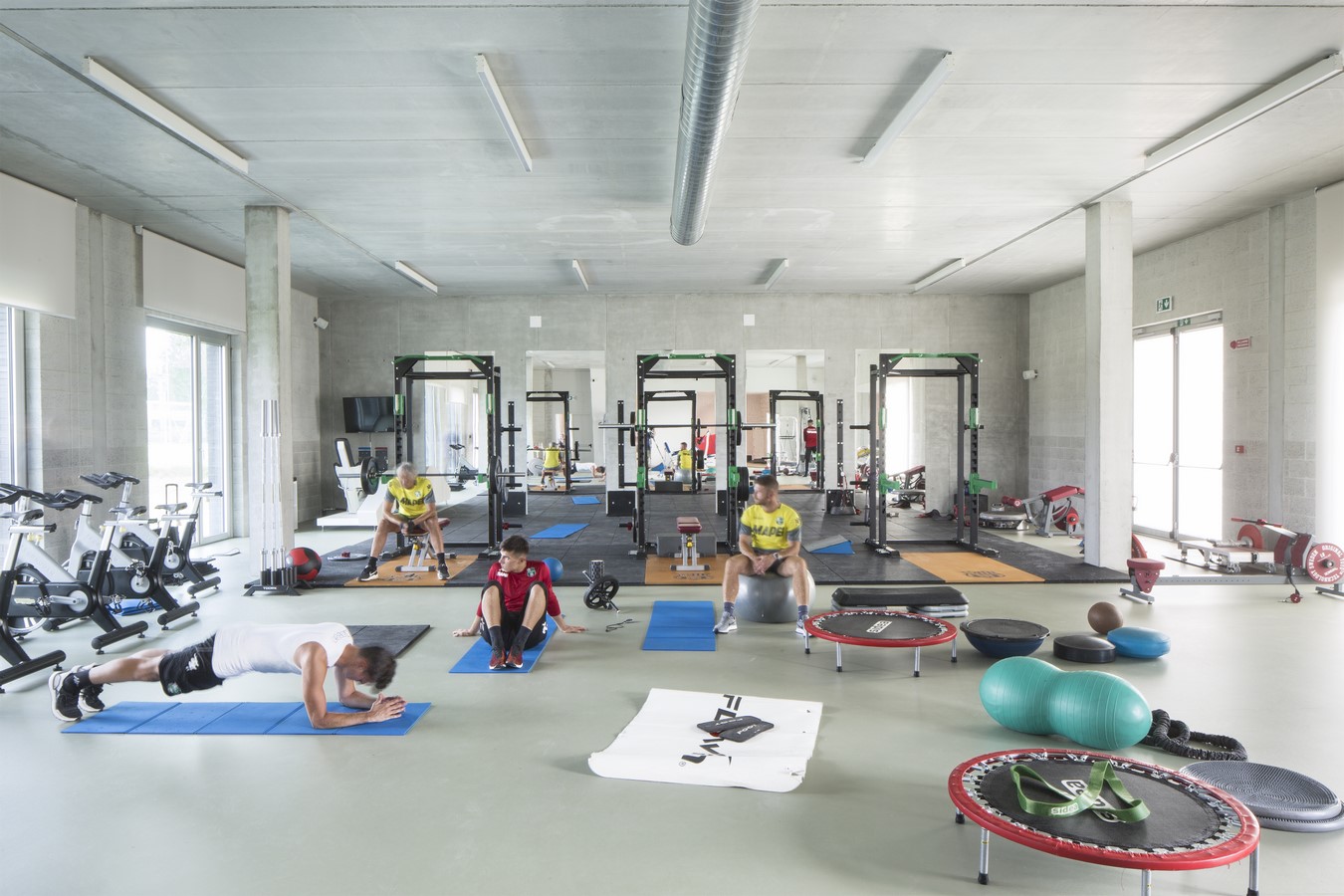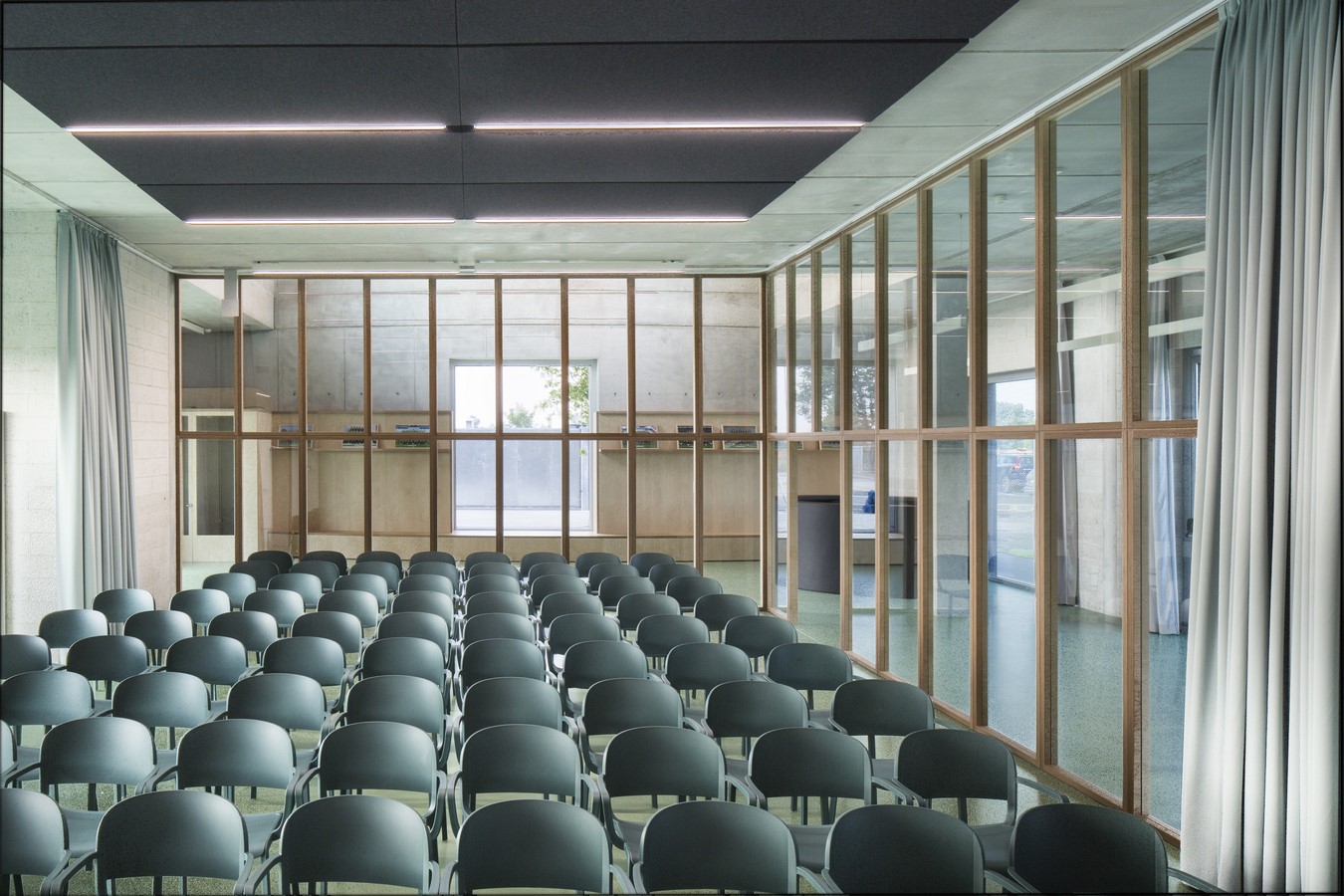Questions
Sassuolo is a small town of 40,000 inhabitants, close to Modena, along the Via Aemilia. The training centre for its Serie A football club was built on public land through a public-private partnership with the local authority. After 30 years the building will become entirely public.
Location: Via Regina Pacis, 41049 Sassuolo (MO), Italy
Client: U.S. Sassuolo Calcio Spa
Design phase
Architectural design: Onsitestudio srl
Project team: Angelo Lunati, Giancarlo Floridi
Project architect: Cesare Galligani, Paolo Volpetti, Marco Fancelli, Nicolò de Paoli, Veronica Lazzaro, Davide Macchi, Pietro Manazza, Michele Miserotti.
Structural project: Milan Ingegneria srl
Ing. Maurizio Milan, Ing. Giovanni Molteni, Ing. Marco Lettieri
MEP: Deerns Italia spa
Ing. Giovanni Consonni, Ing. Giuseppe Dibari, Ing, Riccardo Diaferia, Ing. Davide Bonetto, Ing. Angelo Pollace
Photography: Filippo Romano
Stefano Graziani
Construction phase
Artistic supervision: Onsitestudio srl
Project team: Angelo Lunati, Giancarlo Floridi

The centre provides training facilities and offices for Sassuolo FC athletes and staff, as well as a press room and a covered stand for 200 people. Alongside the building, there is a complex of 8 different football pitches with both artificial and natural turf. The football club trains 20 teams in 20 different leagues, involving around 600 people from 6 to 40 years old.
The project posed a double challenge: first, to understand exactly how a football training centre functions, and then to give the building a typological and formal dimension that goes beyond that function.
The design attempts to answer a series of concrete questions. What form should a new building take in the landscape? What is the character of a building that goes beyond its function? How do you fulfil the need for representation in such a mediatised sport? Is it possible for a contemporary building to embody the dimension of duration?
Form
The project seeks to mediate between two distinct themes: on the one hand, the suburban situation, with its industrial buildings, warehouses, truck parks and scattered traces of the former agricultural landscape; on the other, the abstract, geometric character of the training grounds, traced in the white lines on the pitches.
The images in Luigi Ghirri’s Esplorazioni sulla Via Emilia (Explorations along the Via Aemilia), from the summer of 1986, speak of a territory shaped by the often dramatic, conflictual relationship between past and present, between contemporary and enduring historical conditions. In this context, the photo of the small settlement of Cittanova, a few kilometres from the site of the project, seemed particularly interesting. Cittanova is part of the complex territorial system that has developed over the centuries along the Via Aemilia, with the line of the Roman road generating a network of urban routes and organisms that define the essential structure of the Po valley. The image shows the facade of the church, frontal and orthogonal to the street, which is aligned with the centuriation grid. The facade has an iconic two-dimensional character that is at once simple and monumental. Another Ghirri image from the same book shows a football match where the flat landscape merges with the pitch and the strong light on the game gives way to the absolute darkness of the background. The relationship that the new building wants to establish with the territory is, in the same vein, both synthetic and complex, simple and ambiguously monumental. The built volume, which is the length of a football pitch, establishes a clear spatial and volumetric relationship with the horizontality and emptiness of the flat landscape. A calm presence visible from a great distance, it forms a distinctive landmark that invests the historical memory of the horizontal system of the agrarian plain with new meaning. Its stepped volume is oriented like a decumanus in the same direction as the abstract centuriation grid, covering what was once agricultural and is now sports fields.

Character and function
A functionalist approach typically results in a mechanical aggregation of the different functions of a building, in which each element is defined by its particular use and expresses its own autonomous values in terms of form and typology, language and materials.
Rejecting that naïve desire for a correspondence between form and function, the project seeks a synthetic language that relates to the overall expression of the building, rather than the representation of its individual functions. Its references are therefore historical buildings – traditional sports facilities and agrarian structures – that convey a pragmatic character through their somewhat archetypal forms and their compactness, sobriety, and expression of the structure. Typologically, the training centre draws on the linear elements of rural service buildings, such as the porticoed barchesse or their Greek and Roman forerunners, which are arranged longitudinally along the edge of fields, with the form being defined in relation to the open space.
The building sits on the ground without a plinth, directly connected to the soil, like its humble agricultural and manufacturing predecessors. Engaging with a tradition, or attempting somehow to invent one, the project uses various forms, types and characters found in historical service buildings: a linear spatial organisation, unitary material, repetition of structure and facade as a form of representation, absence of cladding, colours corresponding to the nature of the materials themselves, arches, arcades, a stepped section, pragmatic use of symmetry.
Monumentality and background
If for Pasolini football represents a “basic rite and evasion, the last sacred representation of our time”, then the training centre represents the most mysterious, most secret part of the preparation of the liturgy.
The autonomous form has elements of monumentality, reflecting the building’s strong collective role while also expressing the essential representative quality now expected of the headquarters of a football club, especially in Italy. In contrast to the current slick representation of football, however, the character of the training centre for this provincial club resides more in the sober and unadorned tone of a frugal and poetic place – the backdrop for the build up to the performance. Any theatricality is left to the match in the stadium.
The absoluteness of the form of the building derives from its placement as the limit between two identical football pitches, and from its dimensions, derived from the space of the game. Its stepped section offers identical and continuous views of both pitches from every point of the building.
Likewise, the regular, longitudinal repetition of a single symmetrical section creates elevations that are practically identical, differentiated in just a few precise ways. The project seeks to form a backdrop that is at once neutral and stimulating. The clarity of its expression, as a single synthetic organism, helps to contain the heterogeneity and vitality of the functions of a complex program.
Just as a soccer ball is not round but is more closely related to diverse faceted surfaces than to an ideal sphere, the building does not translate function directly to form, or vice versa. Rather than being the sum of functional elements (like recent suburban expansions), the project is a single building articulated by organising the functional program vertically in a logical but non-hierarchical sequence (first-team athletes, youth squads, staff and managers).

Facades
The long facades of the building, with their straight, dark brick surfaces, are intended to assert a strong physical presence in the landscape, one that refers to the Via Aemilia’s productive tradition of quality and reserve. This expression of solidity not only reinforces the synthetic quality of the building but also gives it a sober, monumental character appropriate to this rural setting, underpinning the sense of a new collective resource and a “newly invented tradition”.
The character of the long facades is consistent with the general scale of the volume: the openings are proportionate to the size and articulation of a sports centre, rather than being directly derived from the internal spaces, as in a building with a domestic tone.
Each of the short sides, on the other hand, has a distinct character. While the south end is blank, indifferent to any expressiveness, the north end, which contains the main entrance, forms a shallow curved facade. Its lower part, with an integrated bench, is made of polished precast concrete, while its upper part is of brick, laid in stretcher bond. The shadowing of the protruding rows of brickwork further enhances the ambiguous monumentality of this little facade, resonating with the lack of cladding and harsh beauty of unfinished historical facades like S Lorenzo in Florence or S Petronio in Bologna.
From a distance the building appears as a single mass of the same material: dark grey brick, laid horizontally to accentuate the three different orders of floor height and the regular span of the structure.
Balconies are placed along the facades in accordance with the maximum allowable external surface areas. Their profile is curved to avoid intercepting the building volume, except at a single discreet point.

Matter
On the exterior a dark and hard earth-coloured brick is used to form a series of recessed window wall bays. The width of the bays increases on the two upper floors, giving the areas in between them the look of flattened, tapering buttresses. Within the uniform grain of the building’s thick masonry skin, lintels in light polished precast concrete act as ornamental friezes marking the main entrances and openings.
The interior is formed of exposed materials that correspond directly to the structure – concrete cast in situ and precast as the floor plate, as in the Rossi building in nearby Modena, and wall partitions made of concrete bricks. Flooring is the same green resin everywhere, apart from the service areas (green anti-slip tiles), the gym (greenish linoleum) and the offices (wood). With no further finishing or cladding, the interior has the same sober and pragmatic character as the exterior.
The internal walls on the perimeter and main circulation corridors are in white cellular concrete blocks with two finishes: rough and smooth. The blocks are left exposed up to a height of 1.4m to reduce the need for cleaning and minimise maintenance in the long and often crowded spaces.
All metalwork, such as balustrades and handrails, are in grey steel, while the windows are in natural-coloured aluminium.
Ancillary buildings, such as the grandstand and electrical substation, are reinforced-concrete structures clad in dark grey cellular concrete blocks.
Program
The program of the main building is divided over four floors – three above ground, one below. The ground floor contains the public spaces, including a small auditorium, along with the facilities for the Serie A team, and offers access to the playing fields on either side. The first floor is for the youth squads, while the second floor contains offices and staff meeting rooms. The basement level is for visitor and public use.
Facilities for the Serie A team include: physiotherapy, laser room, gymnasium, changing rooms, toilets, showers, ice bath, relaxation room, coach’s office and separate changing rooms for the coaching and other technical staff.
The first-floor spaces for the youth squads contain: physiotherapy with offices, laser room, technical office and locker room, shared toilets, showers, ice bath, dedicated stairway to the pitches, gym, offices for the managers of the youth squad.
The management offices on the second floor are arranged in an extended linear sequence of individual and shared workspaces, meeting rooms and services, providing views from any room onto the playing fields and the landscape.
The basement houses the changing rooms for visiting teams and public use, technical plant, storage spaces, laundry room and hydrotherapy pool.
The covered grandstand building can accommodate up to 200 spectators. Beneath it, there are spaces for storing equipment, public toilets and an indoor area with vending machines. There are no fences dividing the playing fields.
The service building to the north contains an MV/LV transformer substation, a technical room with a generator, a waste room and a bike shed.

Access
The main access to the sports centre is from the square to the north, which is connected to the public highway through the concession area on via Regina Pacis. A second, internal road to the north leads to a public car park. On this north side, two entrances with galvanised steel gates serve both vehicles and pedestrians, while there is a further pedestrian entrance to the south, via the existing car park by the Ca’ Marta Centre.
The first-team pitch, and the freight elevator for suppliers, are accessed from the east side of the building. On the west side, the pitch is connected to both the youth squad changing rooms on the first floor and the visiting team facilities in the basement.
Access to the first-team, youth and office areas is controlled with respect to the general flows of the building through the atrium and the main staircase. Visitors can access the basement from both the main and the secondary staircase, but not from the rest of the building. For functional reasons, the vertical circulation of the building is divided between two staircases. All floors are served by an elevator and a freight elevator.
Levels
The ceiling height on the ground floor, at 4m, reflects the representative character of the spaces on this level. At the entrance on the north end of the building, a double-height area contains the reception and access to the small auditorium. Beyond this, the spaces for the first team are served by a 1.8m-wide glazed corridor that overlooks their dedicated pitch on one side and gives onto a series of atria on the other. The atria vary in shape, depending on the role of the spaces they access, and form part of a central band of service elements that acts as a buffer between the circulation area and the physiotherapy, coach and technical offices, preserving their privacy both visually and acoustically. The first-team changing rooms then constitute an autonomous area, focused around a large oval element, finished in timber, which contains the lockers with benches and service spaces (for linen, tools, etc). The oval room is set back from the facade both to prevent anyone looking in (as required by Italian Olympic Committee rules) and to ensure the necessary soundproofing. The circulation area within the changing rooms connects the oval room with the relaxation area and the sanitary block with toilets, showers and ice bath. At the south end, the gym extends over the entire width of the building. The structure of the pillars defines a large central space – the teaching area – and lateral bands towards the facades, which become circulation spaces.
The first floor has a ceiling height of 3.4m. The youth squad area is served by a 1.8m-wide circulation corridor. On the east side it is extensively glazed and overlooks the first-team pitch. On the west it gives onto the youth squad spaces – changing rooms, offices, physiotherapy, and their own dedicated pitch. At the south end, the gym again extends over the entire width of the building, and this time also incorporates a double-height area. The changing rooms are identical spaces, arranged perpendicular to the corridor, with showers accessible from their long sides. A toilet area common to all the changing rooms (with three cubicles and a common circular channel sink) is located at the stairs leading to the ground floor and the exit to the pitch. All spaces can be accessed through doors in small setbacks along the main corridor. The management offices for the youth squad are located at the main staircase, alongside a small service space and a break area.
On the top floor, the ceiling height is 3m. This entire floor is the preserve of the management of the sports club, with offices as well as toilets, a server and printer space, a large meeting room and external terraces on both sides of the building. A hatch with a retractable ladder provides maintenance access to the top of the building. The roofs are all flat, with a system of channels for water collection. The ones on the first and second floor span 2m and are made with a sloping screed, a waterproofing membrane and a top layer of dark gravel.
Bio – Onsitestudio
Onsitestudio is an architectural practice founded in Milan in 2011, headed by Angelo Lunati and Giancarlo Floridi. Onsitestudio believes in a close relationship between culture and professionalism, also by its teaching at the School of Architecture and research at DAStU, Politecnico di Milano. Among the studio’s recent achievements are the hotel building in Piazza Duca d’Aosta, the cultural center BASE and the Pirelli Learning Center in Milan, the new Hotel Palace in Brussels, the Manifattura Tabacchi masterplan for social housing in Piacenza and the BEIC European library in Milan. Onsitestudio’s works have been internationally exhibited, widely published and collected in a monograph book published by Quart Verlag. In 2020 Onsitestudio was selected by the architecture magazine Domus to feature among the world’s 50 most innovative practices.
Giancarlo Floridi (Modena, 1973) graduated from Politecnico di Milano in 1999, studied mainly at Escuela Tecnica Superior de Arquitectura de Madrid and received a PhD at Politecnico di Milano in 2005. He carries out research at DAStU, Politecnico di Milano, and teaching activities as Adjunct Professor at Politecnico di Milano since 2010 and Visiting Professor at IUAV in 2014 and 2021, GSD Harvard 2022.
Angelo Lunati (Milan, 1973) graduated from Politecnico di Milano in 1998, studied also at Facultade de Arquitectura do Porto and received a PhD at ETH Zurich in 2018. He carries out research at DAStU, Politecnico di Milano and teaching activities as Adjunct Professor at Politecnico di Milano since 2010 and Visiting Professor at IUAV in 2014 and 2021, TU WIEN 2021–2022, GSD Harvard 2022.



















